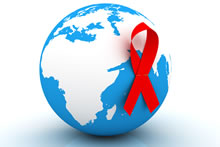
In the United States alone, approximately 50,000 new infections occur each year—a number that has remained largely unchanged since the 1990s.
In an innovative approach to HIV prevention, an interdisciplinary group of experts has come together for the first time to lay out a framework of best practices to optimize the role of the clinician in achieving an AIDS-free generation.
Published online in the Journal of the American Medical Association (JAMA), the recommendations integrate both cutting-edge biomedical advances and evidence-based behavioral interventions for the care of people living with HIV or at high risk for HIV infection.
The recommendations, developed by an expert volunteer panel assembled by the International Antiviral (formerly AIDS) Society–USA (IAS-USA), are intended as guidelines for clinicians to implement a combined biomedical-behavioral approach to HIV care and prevention. They are based on a comprehensive review of data that was either published or presented at scientific conferences over the past 17 years.
Among the new recommendations is a call for the use of antiretroviral therapy (ART), which suppresses HIV replication and virtually eliminates the risk of transmitting the virus, for all HIV-infected individuals and as pre-exposure prophylaxis (PrEP) for HIV-uninfected individuals at high risk of infection. The guidelines emphasize the integration of behavioral and social interventions—such as psychosocial counseling or treatment for drug dependence—in health care systems to help individuals living with HIV or at high risk for infection to access and remain in high quality HIV care.
"The tools to prevent HIV infection and disease progression are better than ever, but providers need encouragement and support to integrate best practices in communication and counseling with the biomedical measures that can render patients less- and ideally non-infectious," says Jeanne M. Marrazzo, MD, MPH, professor of medicine at the University of Washington; medical director of the Seattle STD/HIV Prevention Training Center; a co-chair of the IAS-USA panel; and corresponding author of the paper.
According to the recommendations, the availability of combination antiretroviral therapy (ART) has changed the lives of millions of individuals living with HIV, transforming HIV from a fatal infection to a manageable chronic disease. But while the incidence of new HIV-1 infections worldwide has decreased by an estimated 33 percent since 2001, it still remains high—approximately 2.3 million new infections occurred in 2012. In the United States alone, approximately 50,000 new infections occur each year—a number that has remained largely unchanged since the 1990s.

Carlos del Rio | See Expert Bio
"We are at a time where scientific advances in HIV allow us to effectively implement interventions that could stop HIV transmission," says Carlos del Rio, MD, chair of the Department of Global Health at the Rollins School of Public Health at Emory University, professor of medicine at Emory University School of Medicine, co-director of the Emory Center for AIDS Research, co-chair of the IAS-USA Panel, and a member of the IAS-USA volunteer board of directors. "But the success of both biomedical and behavioral HIV prevention measures depends on clinicians’ ability and willingness to implement them."
"These guidelines provide a practical, science-based approach that any clinician can implement," says David Holtgrave, PhD, chair of the Department of Health, Behavior and Society at the Johns Hopkins Bloomberg School of Public Health and a co-chair of the IAS-USA Panel. "They are designed to promote the integration of the best available services—both behavioral and biomedical—and to create a clear pathway to access these services and realize their full benefit."
The panel’s recommendations include the following:
All adults and adolescents should be tested at least once for HIV, with repeated testing for those at increased risk of acquiring HIV.
Clinicians should be alert to the possibility of acute HIV infection and promptly pursue diagnostic testing if infection is suspected.
Individuals diagnosed with HIV should be linked to care for timely initiation of antiretroviral therapy (ART).
Support for adherence and retention in care, individualized risk assessment and counseling, assistance with partner notification, and periodic screening for common sexually transmitted infections (STIs) should be included in the care of HIV-infected individuals.
Uninfected persons at high risk of HIV infection should be prioritized for interventions such as pre-exposure prophylaxis (PrEP) and individualized counseling on risk reduction.
Daily emtricitabine/tenofovir disoproxil fumarate is recommended as PrEP for persons at high risk for HIV based on recent diagnosis of STIs, use of injection drugs or shared needles, or recent use of post-exposure prophylaxis; ongoing use of PrEP should be guided by regular risk assessment.
For persons who inject drugs, harm reduction services should be provided (needle and syringe exchange programs, supervised injection, and available medically-assisted therapies, including opioid agonists and antagonists). Low-threshold detoxification and drug cessation programs should be made available.
Post-exposure prophylaxis (PrEP) is recommended and should be initiated as soon as possible for all persons exposed to HIV from a known infected source.
The recommendations note that while implementing them may present structural, economic, or political challenges, the benefits should be substantial in preventing disease progression, promoting the gain of healthy life years and preventing new HIV infections.
In addition to Marrazzo, del Rio and Holtgrave, panel members included Myron S. Cohen, MD, University of North Carolina at Chapel Hill; Seth C. Kalichman, PhD, University of Connecticut; Kenneth H. Mayer, MD, Harvard Medical School; Julio S. G. Montaner, MD, University of British Columbia; Darrell P. Wheeler, PhD, MPH; Loyola University Chicago; Robert M. Grant, MD, MPH, University of California San Francisco; Beatriz Grinsztejn, MD, PhD, Evandro Chagas Clinical Research Institute (IPEC)–FIOCRUZ; N. Kumarasamy, MD, YR Gaitonde Centre for AIDS Research and Education; Steven Shoptaw, PhD, University of California Los Angeles; Rochelle P. Walensky, MD, MPH, Massachusetts General Hospital; Francois Dabis, MD, PhD; Université de Bordeaux; Jeremy Sugarman, MD, MPH, The Johns Hopkins University; and Constance A. Benson, MD, University of California San Diego.
IAS-USA is a 501(c)(3) not-for-profit organization that sponsors continuing medical education for physicians and medical practitioners involved in the care of people with HIV, HCV, or other viral infections. IAS-USA, located in San Francisco, sponsored and funded the guidelines entirely. In this same issue of JAMA another expert volunteer panel brought together by the IAS-USA is publishing updated recommendations for the use of antiretrovirals for the treatment of HIV-1 infected adults. The IAS-USA treatment guidelines are widely used by clinicians since they were first published in 1996.
